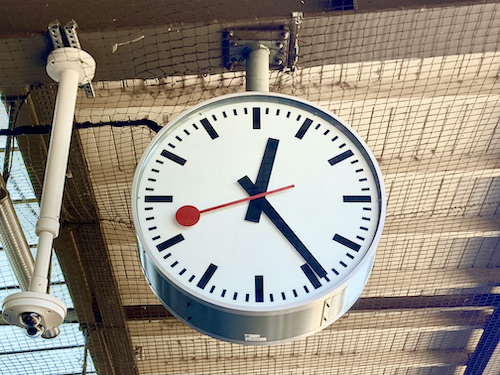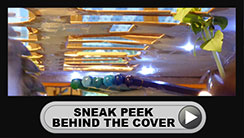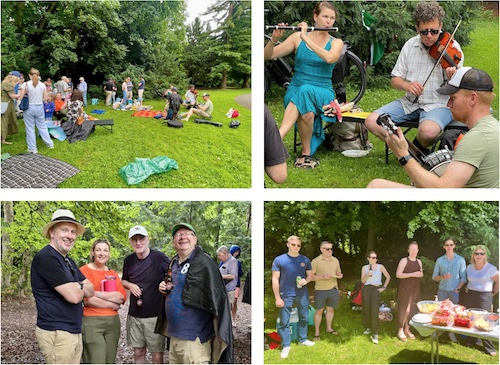
Geneva Irish Association annual picnic
In 1975, Séamus (Jimmy) Magee and his Swiss wife, Evelyne and young daughter Deborah, moved from London to Geneva to work at the European Broadcasting Union. The Geneva from 1975 was not that of today. There was, at the time, relatively little in the way of hobbies and cultural activities… Jimmy amongst his family spoke often of Ireland and the idea to found L’Association Irlandaise de Genève (Geneva Irish Association: GIA) came to him.
He made contact with the Irish Mission in Geneva who gave him the names and addresses of Irish residents in Geneva and its surrounds - luckily there were no GDPR concerns at the time! Jimmy wrote to them, proposing that they join the new association. Several were happy to join and become Committee Members. Thus, the GIA was born on the 27th of September 1975.
Jimmy put a lot of effort into maintaining links with Ireland and Irish culture. At the centre of the GIA, members had access to Irish films (ordered from Bern by Brian Scanlon), could take Irish language courses as well as dance lessons (given by Mary Kehrli-Smyth and Angela Jeangros) and could participate in play reading sessions organised by Sarah and Mick Browne. In addition, there was organised annually a rally and a picnic (which involved booking the chosen mountain refuge months in advance) and a Christmas celebration for the children. The most important day of the year is Saint Patrick’s Day of course. This occasion saw musicians come over from Ireland and board with the families of GIA members.
Fast forward to today as we celebrate our 50th anniversary in September 2025, making us the oldest Irish Association in Switzerland and one of the oldest in Europe!

Seeing the colors, the varieties and amazing selection of seed packages and seedling plants at nearby garden centers and supermarkets, who wouldn't want to start a little garden plot? Maybe you could just start with 3 pots to get the hang of it instead of planting in full ground.
Some annuals are best seeded directly in the garden in spring whereas some can be nurtured in little starter plug pots and then transferred outdoors once the freezing temperatures have finished. Side note on this subject, known in French as Saint de Glace, here is an excerpt from the latest Know-it-all passport®:
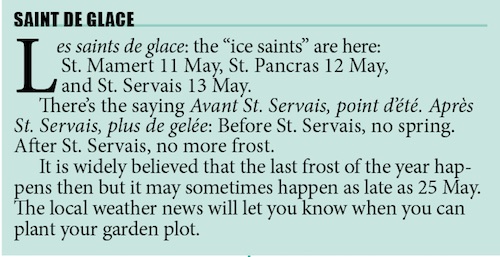
As we have had some unpredictable weather in the last weeks, one has to pay attention to these wise words from history: Avant St, Servais, point d'été. Après St. Servais, plus de gelée (Before St. Servais, no spring. After St. Servais, no more frost).
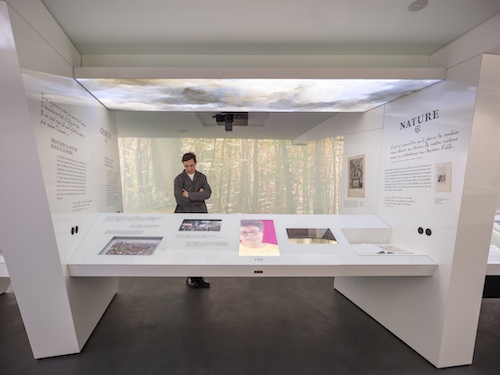
Photo credit: ©DylanPerrenoud
When we heard that the Maison Rousseau et Littérature (MRL) in Geneva was giving tours in English, we had to catch up with the people involved. The tour guide, Ariel Pierre Haemmerlé, who we know personally through articles here about his tours of Carouge, and recent books about Geneva here, here, and here, makes this connection extra special. We caught up with Sabrina Colongo, in charge of Communication for MRL, who answered a few of our questions.
What has been the inspiration behind this tour?
We wanted to share the story and principles of Rousseau under a modern and relevant light. That’s why the Rousseau Path, instead of following a classic chronological/biographical order, is organised between 7 recurring thematic aspects of his work: nature, freedom, happiness etc. The permanent exhibitions clearly shows how relevant his views still are today.
The history of MRL
Born from the merge in 2012 of "L’Espace Rousseau" and la "Maison de la littérature" after years of negociation, it is the result of a dream that some may have called… a little bit crazy. For the past decade, it has fulfilled its two main purposes : honor the memory and the work of Jean-Jacques Rousseau, and promote French-Swiss literature to a very diverse audience (students, locals, senior citizens, children, people with disabilities, tourists etc.).
What is the biggest obstacle MRL has had to overcome in the last years?
Probably the merge of the two associations followed by the thorough refurbishement of the building. What a challenge! We are proud to be where we’re at now and we are also looking forwrad to what the future has to offer.

Living in Nyon (LIN) was founded in 2009 by Catherine Nelson-Pollard, a British writer who fell in love with this charming Swiss town. She created a platform that beautifully captured Nyon's essence, offering insights and stories that resonated with both locals and newcomers.
In 2019, Mandy Bronsil took over the reins, keeping the site running and transforming it into an Association. With her natural gift for connecting people, she brought in sponsors, building meaningful relationships to keep the community spirit alive. Seema Sharma joined Mandy a few years later, infusing her creative flair and deep appreciation for Nyon into the project.
At the start of 2025 Mandy and Seema felt it was time to refresh the website and logo to reflect the evolving community and the dynamic spirit of Nyon.
Catherine Nelson-Pollard, had a look at the new website and commented, "I am delighted with Living in Nyon’s new look. From the simple blog I started over sixteen years ago, it has now evolved into something much more. This latest update is fresh, clean and easy to read whilst still keeping the core values it began with, that is, to celebrate all that is wonderful about the town, along with giving practical advice for newcomers. Bravo à toute l’équipe!"
What has been the inspiration to renew the logo and website?
We decided to refresh our logo and website to create a platform that truly reflects our personalities and to mirror the growth and vibrancy of Nyon. We aimed to create a fresh, engaging user-friendly platform that not only showcases local events and cultural highlights but also builds deeper connections within our community. This renewal honors the original idea behind Living In Nyon and continues to celebrate Nyon's unique blend of local charm and international energy.
With over a thousand articles published since LIN was founded in 2009, we wanted to update the website so that it is easier to navigate, more engaging, and better suited for locals, newcomers, and visitors alike. Now you will be able to look for recommendations, business spotlights, or upcoming events, faster and more intuitively. AND we couldn't pass up the opportunity to add as much beautiful imagery as we could!
The next time change in Switzerland will take place on Sunday, 27 October 2024 at 03h local time, to switch to winter time. The clocks will then be set back one hour. This means that it gets light earlier in the morning and dark earlier in the evening.
Remember this:
Daylight Saving Time (“DST”) is the practice of moving the clocks forward one hour from Standard Time during the summer months and changing them back again in the fall.
The general idea is that this allows us all to use natural daylight better: moving the clocks forward one hour in the spring grants us more daylight during summer evenings, while moving clocks back one hour in the fall grants us more daylight during winter mornings.
Reset your clocks to standard time
Daylight saving time will come to an end on Sunday, 27 October 2024 at 3am, clocks will go back to 2am. The clocks will not switch to winter time, as there is only standard time and summer time.
In recent years, the possible abolition of the annual time change has become the subject of political debate. However, not all decisions have yet been taken, either at European Union level or in individual countries.
Switzerland is monitoring developments in neighboring countries. It will carefully study the relevance of a possible adaptation of official time and its interest for our country. Until further notice, the current regulations remain in force. So it can already be said today that next spring, on Sunday, 30 March 2025 to be precise, we will be switching back to summer time.
Both at the time of the introduction of Central European time at the end of the 19th century, and when the time change was introduced in Switzerland in the 1980s, the Federal Council and Parliament agreed to align official time with that of our neighboring states. This decision was primarily motivated by economic considerations. An official time that differed from that of our neighboring countries would turn Switzerland into a time island, with all the consequences that such a difference would entail.






